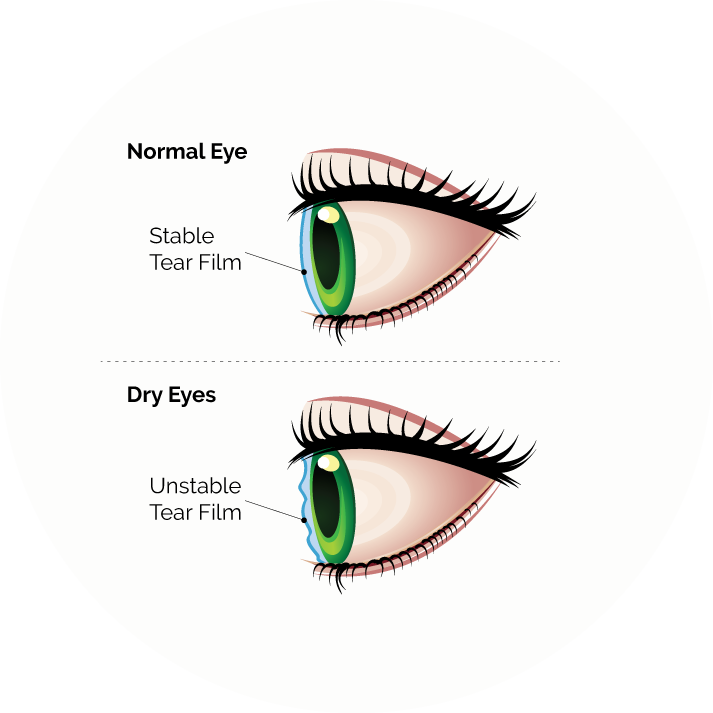Your Dry Eye Optometrist In Lancaster, PA
At Yealy Eye Care, our dry eye specialists are dedicated to diagnosing and treating dry eye syndrome to help you achieve lasting relief and improved eye health. Dry eye syndrome is a common condition that can cause significant discomfort and affect your quality of life. Our team uses advanced diagnostic tools and treatment options to address the underlying causes of dry eye and provide personalized care.
What is Dry Eye Syndrome?
Dry eye syndrome occurs when your eyes do not produce enough tears or when the tears evaporate too quickly. This can result in a lack of lubrication and moisture on the eye’s surface, leading to symptoms such as:
- Burning or stinging sensation
- Redness and irritation
- Blurred vision
- Sensitivity to light
- A feeling of something in the eye
- Watery eyes (as a reflex to dryness)

Common Causes of Dry Eye
Dry eye can be caused by various factors, including:
- Aging: Tear production tends to decrease with age.
- Environmental Conditions: Wind, smoke, and dry climates can exacerbate dry eye symptoms.
- Medications: Certain medications, such as antihistamines and antidepressants, can reduce tear production.
- Medical Conditions: Conditions like rheumatoid arthritis, diabetes, and thyroid disorders can contribute to dry eye.
- Prolonged Screen Use: Staring at screens for extended periods can reduce blink rate, leading to increased evaporation of tears.
Our Comprehensive Dry Eye Services
Advanced Diagnostics:
We use state-of-the-art diagnostic tools to evaluate the quality and quantity of your tears and assess the health of your ocular surface. This includes:
- Tear Osmolarity Testing: Measures the concentration of your tears to identify imbalances.
- Meibography: Examines the meibomian glands, which produce the oily layer of your tears.
- Ocular Surface Staining: Uses special dyes to highlight areas of dryness or damage on the eye’s surface.

Personalized Treatment Options:
Based on the results of your diagnostic tests, we develop a customized treatment plan to address the underlying causes of your dry eye. Our treatment options include:
Prescription Eye Drops:
Medications like cyclosporine (Restasis) and lifitegrast (Xiidra) help increase tear production and reduce inflammation.
Punctal Plugs:
Tiny plugs inserted into the tear ducts to prevent tears from draining away too quickly, keeping the eyes moist.
LipiFlow:
A thermal pulsation treatment that clears blockages in the meibomian glands, improving the quality of the oily layer of your tears.
Intense Pulsed Light (IPL) Therapy:
Uses light pulses to reduce inflammation and improve gland function in cases of meibomian gland dysfunction.
Prokera®:
A therapeutic device made from amniotic membrane tissue that promotes healing and reduces inflammation on the eye’s surface.
TearCare:
A device that applies localized heat and pressure to the eyelids, helping to clear blockages in the meibomian glands.
Lifestyle and Home Remedies:
We provide guidance on lifestyle changes and home remedies to help manage your dry eye symptoms, including:
- Using a humidifier to add moisture to the air
- Taking regular breaks during screen use
- Staying hydrated
- Wearing sunglasses to protect your eyes from wind and sun
Your prescription medications could be causing Dry Eye:
Why Choose Yealy Eye Care for Dry Eye Treatment?
Our optometrists have specialized training and extensive experience in diagnosing and treating dry eye syndrome.
- Advanced Technology: We use the latest diagnostic and treatment technologies to provide effective and long-lasting relief.
- Personalized Care: We develop individualized treatment plans tailored to your specific needs and monitor your progress to ensure optimal results.
- Comprehensive Services: From advanced treatments to lifestyle recommendations, we offer a full range of services to manage dry eye syndrome.
If you are experiencing symptoms of dry eye, don’t wait to seek relief. Schedule a consultation with our dry eye specialists at Yealy Eye Care to receive a thorough evaluation and personalized treatment plan. Our team is dedicated to helping you achieve comfortable, healthy eyes.
Contact Us for Dry Eye Relief
If you’re seeking relief for your dry eyes, Our Team of Dry Eye Experts can help. Yealy Eye Care's Dry Eye Clinic serves patients from Lancaster County, Lancaster Township, York, East Petersburg, and throughout Pennsylvania.



